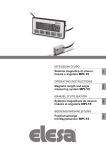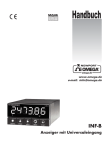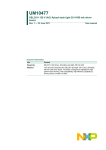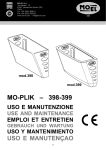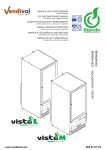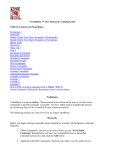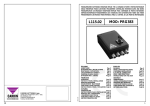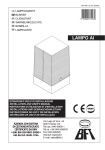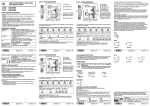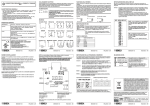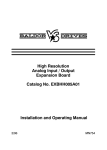Download Instructions CONVERTISS
Transcript
Istruzioni per installazione, uso e manutenzione Anleitungen für Einbau, Betrieb und Wartung Installation, use and maintenance instructions Manuel d’entretien I D GB F Kit convertitore di segnale analogico Analogischer Signalwandler-Kit Analogic signal converter kit Kit convertisseur de signal analogique E 5202 CODICE - CODE 3010390 3010410 3010415 2916224 (2) - 12/2007 I Il convertitore E 5202 è uno specifico dispositivo dedicato alla gestione di servomotori (pilotati con comando a 3 punti) e al controllo della loro posizione quando il segnale in ingresso proveniente da un dispositivo principale di controllo è un segnale standard analogico 0/4÷20mA o 0/2÷10V. Deve essere collegato ad un Potenziometro da ordinare a parte con un codice specifico, come indicato nella tabella sottostante. Codice Kit Convertitore di segnale Applicazione su bruciatori serie: Kit Potenziometro RS 28-38-50 VA 3020072 3010390 RS 300-400-500/M RS 300-400/P 3010402 3010393 3010410 3010415 RS 25-35/M - RS 34-44/M RS 250/M 3010420 3010416 DATI TECNICI Segnali in ingresso Reazione Uscita Isteresi (Banda Morta) Alimentazione elettrica Potenza elettrica assorbita Temperatura di funzionamento Temperatura di immagazzinamento Contenitore Electrical protection Approvazioni 0/2÷10V (impedenza 200 kΩ) 0/4÷20mA (impedenza 250 Ω) selezionabili tramite ponticelli dal retro Potenziometro a 3 fili 1÷20 kΩ Relè con contatto N.A., portata massima 250Vac 5A Aggiustabile con trimmer frontale ±0,1% a ±1% 115Vac / 230Vac 50÷60Hz 3VA max 50°C max -20 ÷ +70°C Resina ABS autoestinguente IP40 CE (EMC secondo EN 50081-1, EN 50082-2) (Sicurezza elettrica secondo EN 61010-1) DIMENSIONI DI INGOMBRO E FORATURA PANNELLO 1 2 3 4 5 6 7 8 9 10 11 12 - INC. DEC. N IN + 115V IN DEC. V INC. mA - N IN + 230V IN V mA COLLEGAMENTI MORSETTIERA 1 2 3 4 5 6 7 8 9 10 11 12 Impostazione di fabbrica Alimentazione elettrica: 230V Segnale in ingresso: 0/4÷20mA Impostazioni opzionali (solo se necessario) In caso di alimentazione elettrica 115V spostare il filo dal morsetto 10 al morsetto 11. In caso di segnale in ingresso 0/2÷10V spostare il ponticello al morsetto V. 1 SEGNALE IN INGRESSO POSIZIONE SERVOMOTORE Potenza massima 100% Potenza minima 20% 0% Stop 0 4 20 [mA] 0 2 10 [V] SEGNALE IN INGRESSO Il segnale di ingresso può essere facilmente adattato alla corsa del servomotore, come riportato di seguito: 4 ÷ 20mA corrispondono a 2 ÷ 10V corrispondono a Posizione di MIN del servomotore ÷ Posizione di MAX del servomotore (Potenza MIN ÷ Potenza MAX) Vedere diagramma. Posizione di MIN del servomotore ÷ Posizione di MAX del servomotore (Potenza MIN ÷ Potenza MAX) Vedere diagramma. o per altre applicazioni: 0 ÷ 20mA corrispondono a 0 ÷ 10V corrispondono a Posizione di chiusura del servomotore ÷ Posizione di MAX del servomotore Vedere diagramma. Posizione di chiusura del servomotore ÷ Posizione di MAX del servomotore Vedere diagramma. REGOLAZIONE DEL CONVERTITORE E 5202 • Il convertitore non richiede una taratura specifica; esso adatta la posizione del servomotore al segnale di ingresso 0/4÷20mA (o 0/2÷10V) tramite l’abbinamento al valore della resistenza del potenziometro. • Il convertitore è equipaggiato da un trimmer (Banda Morta) posizionato nel pannello frontale; si raccomanda comunque di regolare il trimmer al valore massimo per evitare una reazione troppo frequente con inutile riposizionamento del servomotore nel caso di variazione del segnale di ingresso molto piccola. Il valore massimo della Banda Morta è 1%, che corrisponde a nessuna reazione di riposizionamento fino a che la variazione del segnale in ingresso è maggiore di 0,2 mA (o 0,1V) (angolo di circa 1°). INSTALLAZIONE DEL POTENZIOMETRO • Installare il Kit Potenziometro (da ordinare a parte) facendo riferimento alle istruzioni fornite a corredo dello stesso. • Verificare il corretto montaggio controllando che la resistenza di 1000 Ω corrisponda esattamente alla corsa MASSIMA del servomotore: angolo di 90° o 130° a seconda del tipo di bruciatore. Questa taratura non deve essere modificata. • Collegare il potenziomentro a 3 fili direttamente al convertitore E 5202, come indicato negli schemi riportati di seguito. • Per il settaggio della posizione di MINIMA, fare riferimento alla taratura di fabbrica del servomotore indicata nel manuale a corredo del bruciatore. 2 INSTALLAZIONE DEL CONVERTITORE I bruciatori sono già predisposti per accogliere il convertitore E 5202. Codice 3010390 (vedere Fig. 1) Inserire il convertitore nell’apposito supporto 1) e fissarlo con le due viti e staffe fornite a corredo del kit. Collegare i cavi uscenti all’apposita morsettiera del bruciatore. Vedere schema elettrico di Fig. 2. 1 Segnale in ingresso 4-20 mA / 0-10 V D3935 1000Ω / 135° per bruciatori serie RS 300-400-500/M 1000Ω / 90° per bruciatori serie RS 300-400/P Fig. 1 Fig. 2 Codice 3010410 (vedere Fig. 3) Inserire il convertitore nell’apposito supporto 1) e fissarlo con le due viti e staffe fornite a corredo del kit. Togliere il coperchio del pressostato 2) ed allentare le due viti di fissaggio fino ad ottenere lo spazio necessario per infilare la staffa 1), agganciandola alle viti stesse. Durante questa operazione si rende necessario far passare il cavo del pressostato all’interno della feritoia 3). Collegare la spina del convertitore alla relativa presa sul bruciatore. Vedere schema elettrico di Fig. 4. 2 1 Segnale in ingresso 4-20 mA / 0-10 V 3 Fig. 3 D7587 Fig. 4 D7586 Codice 3010415 (vedere Fig. 5) Inserire il convertitore nell’apposito supporto 1) e fissarlo con le due viti e staffe fornite a corredo del kit. Collegare la spina del convertitore alla relativa presa sul bruciatore. Vedere schema elettrico di Fig. 6. 1 Segnale in ingresso 4-20 mA / 0-10 V D3936 Fig. 5 Fig. 6 3 D Der Wandler E 5202 ist eine spezifische Vorrichtung, die zur Steuerung von Servomotoren (pilotgesteuert mit 3-PunktSteuerung) und zur Kontrolle deren Position dient, wenn das Eingangssignal von einer Hauptsteuervorrichtung ein analoges Standardsignal von 0/4÷20mA oder 0/2÷10V ist. Er muss an ein Potentiometer angeschlossen sein, das separat mit einem speziellen Code gemäß den Angaben in der nachfolgenden Tabelle bestellt werden kann. CODE Signalwandler-Kit Anwendung bei Brennern der Serie: Potentiometer-Kit RS 28-38-50 VA RS 300-400-500/M RS 300-400/P RS 25-35/M - RS 34-44/M RS 250/M 3010390 3010410 3010415 3020072 3010402 3010393 3010420 3010416 TECHNISCHE DATEN Eingangssignale 0/2÷10V (Impedanz 200 kΩ) 0/4÷20mA (Impedanz 250 Ω) wählbar mittels Steckbrücken auf der Rückseite 3-poliges Potentiometer 1÷20 kΩ Relais mit Schließerkontakt, maximale Leistung 250Vac 5A Einstellbar mit Trimmer auf der Vorderseite von ±0,1% bis ±1% 115Vac / 230Vac 50÷60Hz max. 3VA max. 50°C -20 ÷ +70°C Selbstlöschendes ABS-Kunstharz IP40 CE (EMC gemäß EN 50081-1, EN 50082-2) (Elektrische Sicherheit gemäß EN 61010-1) Reaktion Ausgang Hysterese (Totbereich) Stromversorgung Leistungsaufnahme Betriebstemperatur Lagertemperatur Gehäuse Elektrischer Schutz Zulassungen ABMESSUNGEN UND PLATTENBOHRUNG 1 2 3 4 5 6 7 8 9 10 11 12 - ANST. ABST. N IN + 115V IN ABST. V ANST. mA - N IN + 230V IN V mA KLEMMLEISTENANSCHLÜSSE 1 2 3 4 5 6 7 8 9 10 11 12 Werkseinstellung Stromversorgung: 230V Eingangssignal: 0/4÷20mA Optionale Einstellungen (nur bei Bedarf) Bei einer Stromversorgung mit 115V den Draht von Klemme 10 zu Klemme 11 versetzen. Bei einem Eingangssignal von 0/2÷10V die Steckbrücke zu Klemme V versetzen. 1 EINGANGSSIGNAL POSITION DES SERVOMOTORS 100% Höchstleistung 20% Mindestleistung 0% Stop 0 4 20 [mA] 0 2 10 [V] EINGANGSSIGNAL Das Eingangssignal kann mühelos dem Hubweg des Servomotors gemäß den nachfolgenden Angaben angepasst werden: 4 ÷ 20mA entsprechen 2 ÷ 10V entsprechen Position MIN des Servomotors ÷ Position MAX des Servomotors (Leistung MIN ÷ Leistung MAX) Siehe Diagramm. Position MIN des Servomotors ÷ Position MAX des Servomotors (Leistung MIN ÷ Leistung MAX) Siehe Diagramm. oder bei anderen Anwendungen: 0 ÷ 20mA entsprechen 0 ÷ 10V entsprechen Schließposition des Servomotors ÷ Position MAX des Servomotors Siehe Diagramm. Schließposition des Servomotors ÷ Position MAX des Servomotors Siehe Diagramm. EINSTELLUNG DES WANDLERS E 5202 • Der Wandler erfordert keine spezielle Einstellung. Er passt die Position des Servomotors dem Eingangssignal von 0/4÷20mA (oder 0/2÷10V) durch Kombination mit dem Wert des Potentiometerwiderstands an. • Der Wandler ist mit einem Trimmer (Totbereich) ausgestattet, der sich auf der Vorderseite befindet. Es wird jedoch empfohlen, den Trimmer auf den Höchstwert einzustellen, um eine zu häufige Reaktion mit einer unnötigen Neupositionierung des Servomotors bei einer sehr geringen Änderung des Eingangssignals zu vermeiden. Der Höchstwert des Totbereichs beträgt 1%, was keiner Reaktion zur Neupositionierung entspricht, bis die Änderung des Eingangssignals größer als 0,2 mA (oder 0,1V) (Winkel von etwa 1°) ist. INSTALLATION DES POTENTIOMETERS • Das Potentiometer-Kit (separat zu bestellen) gemäß den diesem beiliegenden Hinweisen installieren. • Die richtige Montage prüfen, indem kontrolliert wird, ob der Widerstand von 1000 Ω genau dem MAXIMALEN Hubweg des Servomotors entspricht: Winkel von 90° oder 130° je nach dem Brennertyp. Diese Einstellung darf nicht verändert werden. • Das Potentiometer über 3 Pole direkt an den Wandler E 5202 anschließen, wie in den nachfolgenden Schaltplänen angegeben ist. • Zur Einstellung der MINDEST-Position siehe zur Werkseinstellung des Servomotors, die in dem dem Brenner beiliegenden Handbuch aufgeführt ist. 2 INSTALLATION DES WANDLERS Die Brenner sind bereits zur Aufnahme des Wandlers E 5202 ausgelegt. Code 3010390 (siehe Abb. 1) Den Wandler in die zugehörige Halterung 1) einfügen und mit den beiden Schrauben und Bügeln befestigen, die dem Kit beiliegen. Die ausgehenden Kabel an die zugehörige Klemmleiste des Brenners anschließen. Siehe im Schaltplan der Abb. 2. 1 Eingangssignal 4-20 mA / 0-10 V D3935 1000Ω / 135° für Brenner der Serie RS 300-400-500/M 1000Ω / 90° für Brenner der Serie RS 300-400/P Abb. 1 Abb. 2 Code 3010410 (siehe Abb. 3) Den Wandler in die zugehörige Halterung 1) einfügen und mit den beiden Schrauben und Bügeln befestigen, die dem Kit beiliegen. Den Deckel des Druckwächters 2) entfernen und die beiden Befestigungsschrauben lockern, bis der erforderliche Platz zum Einfügen der Rohrschelle 1) entsteht, die an den Schrauben befestigt wird. Während dieses Arbeitsgangs ist es notwendig, das Kabel des Druckwächters im Schlitz 3) durchzuführen. Den Stecker des Wandlers mit der zugehörigen Buchse am Brenner verbinden. Siehe im Schaltplan der Abb.4. 2 1 Eingangssignal 4-20 mA / 0-10 V 3 Abb. 3 D7587 Abb. 4 D7586 Code 3010415 (siehe Abb. 5) Den Wandler in die zugehörige Halterung 1) einfügen und mit den beiden Schrauben und Bügeln befestigen, die dem Kit beiliegen. Den Stecker des Wandlers mit der zugehörigen Buchse am Brenner verbinden. Siehe im Schaltplan der Abb. 6. 1 Eingangssignal 4-20 mA / 0-10 V D3936 Abb. 5 Abb. 6 3 GB The E 5202 converter is a special device for servomotor management (controlled with a three-point command) and the control of their position when the input signal from a main control device is a standard analogue 0/4 – 20mA or 0/2 – 10V signal. It must be connected to a potentiometer, to be ordered separately with a specific code as indicated in the table below. Signal converter kit code Application on standard burners: Potentiometer kit RS 28-38-50 VA RS 300-400-500/M RS 300-400/P RS 25-35/M - RS 34-44/M RS 250/M 3010390 3010410 3010415 3020072 3010402 3010393 3010420 3010416 TECHNICAL DATA 0/2 – 10V (impedence 200 kΩ) 0/4 – 20mA (impedence 250 Ω) can be selected via jumpers from the back Three-wire potentiometer 1to20 kΩ Relay with N.O. contact maximum capacity 250Vac 5A Adjustable with frontal trimmer ±0.1% to ±1% 115Vac / 230Vac 50to60Hz 3VA max 50°C max Input signals Reaction Output Hysterisis (Dead Band) Electrical supply Absorbed electrical power Operation temperature Storage temperature -20 – +70°C Container Electrical protection Approvals Self-extinguishing ABS resin IP40 EC (EMC in compliance with EN 50081-1, EN 50082-2) (Electrical safety in compliance with EN 61010-1) OVERALL DIMENSIONS AND PANEL DRILLING 1 2 3 4 5 6 7 8 9 10 11 12 - INC. DEC. N IN + 115V IN DEC. V INC. mA - N IN + 230V IN V mA TERMINAL BOARD CONNECTIONS 1 2 3 4 5 6 7 8 9 10 11 12 Factory setting Electrical supply: 230V Input signal: 0/4 – 20mA Optional signals (only if necessary) In the case of 115V electrical supply move the wire from clamp 10 to clamp 11. In the case of the 0/2 – 10V input signal move the jumper onto clamp V. 1 INPUT SIGNAL SERVOMOTOR POSITION 100% Maximum power output 20% Minimum power output 0% Stop 0 4 20 [mA] 0 2 10 [V] INPUT SIGNAL The input signal can be easy adapted to the stroke of the servomotor as shown below: 4 – 20mA they correspond to 2 – 10V they correspond to MIN servomotor position - to the MAX servomotor position (MIN power output – MAX power output) See diagram. MIN servomotor position - to the MAX servomotor position (MIN power output – MAX power output) See diagram. or for other applications: 0 – 20mA they correspond to 0 – 10V they correspond to Servomotor closure position – MAX servomotor position See diagram. Servomotor closure position – MAX servomotor position See diagram. E 5202 CONVERTER ADJUSTMENT • The converter does not require specific calibration; it adapts the postion of the servomotor to the 0/4to20mA (or 0/2to10V) input signal through combination with the potentiometer's resistence value. • The converter is fitted with a trimmer (Dead Band) positioned on the front panel; you are anyway recommended to regulate the trimmer to the maximum value to avoid a a reaction that is too frequent with needless repositioning of the servomotor in the case of very small variations of the input signal. The maximum value of the Dead Band is 1%, that corresponds to no repositioning reaction until the input variation signal is more than 0.2 mA (or 0.1V) (angle of around 1°). POTENTIOMETER INSTALLATION • Install the Potentiometer Kit (to be ordered separately) referring to the instructions that accompany it. • Check the propper fitting, making sure that the resistance of 1000 Ω corresponds precisely to the MAIN stroke of the servomotor: angle of 90° or 130° according to the type of burner. This calibration must not be modified. • Connect the three-wire burner directly to the E 5202 converter as shown in the diagram below. • For the setting of the MINIMUM position refer to the factory setting of the servomotor indicated in the manual accompanying the burner. 2 CONVERTER INSTALLATION The burners are already prepared to receive the E 5202 converter. Code 3010390 (see Fig. 1) Insert the converter in the special support 1) and fix it with the two screws and brackets supplied with the kit. Connect the wires that come out to the the appropriate burner terminal board. See the wiring diagram in Fig. 2. 1 Signal on input 4-20 mA / 0-10 V D3935 1000Ω / 135° for burners in the RS 300-400-500/M series 1000Ω / 90° for burners in the RS 300-400/P series Fig. 1 Fig. 2 Code 3010410 (see Fig. 3) Insert the converter in the special support 1) and fix it with the two screws and brackets supplied with the kit. Remove the cover of pressure switch 2) and loosen the two fixing screws until you get the space necessary to insert the bracket 1), hooking it to the screws themselves. During this operation it is necessary to pass the pressure switch wire inside the slot 3). Connect the plug of the converter to the relative socket on the burner. See the wiring diagram in Fig. 4. 2 1 Signal on input 4-20 mA / 0-10 V 3 Fig. 3 D7587 Fig. 4 D7586 Code 3010415 (see Fig. 5) Insert the converter in the special support 1) and fix it with the two screws and brackets supplied with the kit. Connect the plug of the converter to the relative socket on the burner. See the wiring diagram in Fig. 6. 1 Signal on input 4-20 mA / 0-10 V D3936 Fig. 5 Fig. 6 3 F Le convertisseur E 5202 est un dispositif spécifique qui sert à commander des servomoteurs (pilotés avec commande à 3 points) et à contrôler leur position quand le signal en entrée provenant d'un dispositif principal de contrôle est un signal standard analogique 0/4÷20mA o 0/2÷10V. Il doit être connecté à un potentiomètre (à commander à part avec un code spécifique), comme indiqué dans le tableau ci-dessous. Code Kit Convertisseur de signal Application sur brûleur série: Kit Potentiomètre RS 28-38-50 VA RS 300-400-500/M RS 300-400/P RS 25-35/M - RS 34-44/M RS 250/M 3010390 3010410 3010415 3020072 3010402 3010393 3010420 3010416 DONNÉES TECHNIQUES Signaux en entrée 0/2÷10V (impédance 200 KΩ) 0/4÷20mA (impédance 250 Ω) sélectionnables par l'intermédiaire de shunts par l'arrière Potentiomètre à 3 fils 1÷20 KΩ Relais avec contact N.A., portée maximum 250Vac 5A Ajustable avec trimmer frontal ±0,1% à ±1% 115Vac / 230Vac 50÷60Hz 3VA max 50°C max -20 ÷ +70°C Résine ABS auto-extinguible IP40 CE (EMC d'après EN 50081-1, EN 50082-2) (Sécurité électrique d'après EN 61010-1) Réaction Sortie Hystérésis (Bande Morte) Alimentation électrique Puissance électrique absorbée Température de fonctionnement Température de stockage Conteneur Protection électrique Approbations DIMENSIONS D'ENCOMBREMENT ET PERÇAGE PANNEAU 1 2 3 4 5 6 7 8 9 10 11 12 - INC. DEC. N IN + 115V IN DEC. V INC. mA - N IN + 230V IN V mA RACCORDEMENTS BORNIERS 1 2 3 4 5 6 7 8 9 10 11 12 Règlement effectué en usine Alimentation électrique 230V Signal en entrée: 0/4÷20mA Programmations optionnelles (seulement si nécessaire) En cas d'alimentation électrique à 115V déplacer le fil du bornier 10 au bornier 11. En cas de signal en entrée 0/2÷10V déplacer le shunt au bornier V. 1 SIGNAL EN ENTRÉE POSITION SERVOMOTEUR 100% Puissance maximum 20% Puissance minimum 0% Stop 0 4 20 [mA] 0 2 10 [V] SIGNAL EN ENTRÉE Le signal d'entrée peut être facilement adapté à la course du servomoteur, comme reporté par la suite: 4 ÷ 20mA correspondent à 2 ÷ 10V correspondent à Position de MIN du servomoteur ÷ Position de MAX du servomoteur (Puissance MIN ÷ Puissance MAX) Voir diagramme. Position de MIN du servomoteur ÷ Position de MAX du servomoteur (Puissance MIN ÷ Puissance MAX) Voir diagramme. ou pour autres applications: 0 ÷ 20mA correspondent à 0 ÷ 10V correspondent à Position de fermeture du servomoteur ÷ Position de MAX du servomoteur Voir diagramme. Position de fermeture du servomoteur ÷ Position de MAX du servomoteur Voir diagramme. RÉGLAGE DU CONVERTISSEUR E 5202 • Le convertisseur ne demande aucun réglage spécifique; il adapte la position du servomoteur au signal d'entrée 0/4÷20mA (o 0/2÷10V) par couplage à la valeur de la résistance du potentiomètre. • Le convertisseur est équipé d'un trimmer (Bande Morte) placé dans le panneau frontal; il est cependant conseillé de régler le trimmer à la valeur maximum pour éviter une réaction trop fréquente avec un repositionnement inutile du servomoteur en cas de variation du signal d'entrée très petite. La valeur maximum de la Bande Morte est 1%, qui correspond à aucune réaction de repositionnement jusqu'à ce que la variation du signal d'entrée est de plus de 0,2 mA (ou 0,1V) (angle d'environ 1°). INSTALLATION DU POTENTIOMÈTRE • Installer le Kit Potentiomètre (à commander à part) en se reportant aux instructions fournies avec l'équipement. • Vérifier si le montage a été effectué correctement en contrôlant si la résistance de 1000 Ω correspond exactement à la course MAXIMUM du servomoteur: angle de 90° ou 130° selon le type de brûleur. Ce réglage ne doit pas être modifié. • Connecter le potentiomètre à trois fils directement au convertisseur E 5202, en suivant les indications des schémas ci-après. • Pour la position MINIMUM, se reporter au réglage du servomoteur effectué à l'usine et qui est indiqué dans le manuel d'instructions fourni. 2 INSTALLATION DU CONVERTISSEUR Les brûleurs sont déjà programmés pour accueillir le convertisseur E 5202. Code 3010390 (voir Fig. 1) Insérer le convertisseur dans le support 1) prévu à cet effet et le fixer avec les deux vis et étriers fournis avec le kit. Connecter les câbles en sortie au bornier du brûleur prévu à cet effet. Voir le schéma électrique de la figure Fig. 2. 1 Signal en entrée 4-20 mA / 0-10 V D3935 1000Ω / 135° pour brûleurs série RS 300-400-500/M 1000Ω / 90° pour brûleurs série RS 300-400/P Fig. 1 Fig. 2 Code 3010410 (voir figure 3) Insérer le convertisseur dans le support 1) prévu à cet effet et le fixer avec les deux vis et étriers fournis avec le kit. Enlever le couvercle du pressostat 2) et desserrer les deux vis de fixation pour obtenir l'espace nécessaire pour enfiler la bride 1), en l'accrochant aux vis. Pendant cette opération il est nécessaire de faire passer le câble du pressostat à l'intérieur de la fente d'introduction 3). Brancher la fiche du convecteur dans la prise du brûleur correspondante. Voir le schéma électrique de la figure 4. 2 1 Signal en entrée 4-20 mA / 0-10 V 3 Fig. 3 D7587 Fig. 4 D7586 Code 3010415 (voir figure 5) Insérer le convertisseur dans le support 1) prévu à cet effet et le fixer avec les deux vis et étriers fournis avec le kit. Brancher la fiche du convecteur dans la prise du brûleur correspondante. Voir le schéma électrique de la figure 6. 1 Signal en entrée 4-20 mA / 0-10 V D3936 Fig. 5 Fig. 6 3 Con riserva di modifiche - Änderungen vorbehalten! - Subject to modifications - Sous réserve de modifications

















